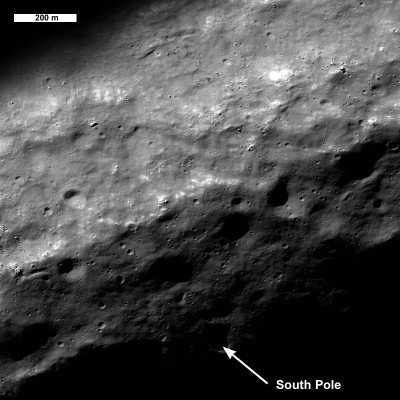First Mapping Orbit Marks Start Of A One-Year Mission
 NASA reported Thursday that its Lunar Reconnaissance Orbiter,
or LRO, has successfully completed its testing and calibration
phase and entered its mapping orbit of the moon. The spacecraft
already has made significant progress toward creating the most
detailed atlas of the moon's south pole to date. Scientists
released preliminary images and data from LRO's seven
instruments.
NASA reported Thursday that its Lunar Reconnaissance Orbiter,
or LRO, has successfully completed its testing and calibration
phase and entered its mapping orbit of the moon. The spacecraft
already has made significant progress toward creating the most
detailed atlas of the moon's south pole to date. Scientists
released preliminary images and data from LRO's seven
instruments.
"The LRO mission already has begun to give us new data that will
lead to a vastly improved atlas of the lunar south pole and advance
our capability for human exploration and scientific benefit," said
Richard Vondrak, LRO project scientist at NASA's Goddard Space
Flight Center in Greenbelt, Md.
LRO is scheduled for a one-year exploration mission in a polar
orbit of about 31 miles above the lunar surface, the closest any
spacecraft has orbited the moon. During the next year, LRO will
produce a complete map of the lunar surface in unprecedented
detail, search for resources and safe landing sites for human
explorers, and measure lunar temperatures and radiation levels.
 "The LRO instruments, spacecraft, and ground systems continue
to operate essentially flawlessly," said Craig Tooley, LRO project
manager at Goddard. "The team completed the planned commissioning
and calibration activities on time and also got a significant head
start collecting data even before we moved to the mission's mapping
orbit."
"The LRO instruments, spacecraft, and ground systems continue
to operate essentially flawlessly," said Craig Tooley, LRO project
manager at Goddard. "The team completed the planned commissioning
and calibration activities on time and also got a significant head
start collecting data even before we moved to the mission's mapping
orbit."
The south pole of the moon is of great interest to explorers
because potential resources such as water ice or hydrogen may exist
there. Permanently shadowed polar craters that are bitterly cold at
their bottoms may hold deposits of water ice or hydrogen from comet
impacts or the solar wind. The deposits may have accumulated in
these "cold-trap" regions over billions of years. If enough of
these resources exist to make mining practical, future long-term
human missions to the moon potentially could save the considerable
expense of hauling water from Earth.
First results from LRO's Lunar Exploration Neutron Detector, or
LEND, indicate that permanently shadowed and nearby regions may
harbor water and hydrogen. Additional observations will be needed
to confirm this. LEND relies on a decrease in neutron radiation
from the lunar surface to indicate the presence of water or
hydrogen.
"If these deposits are present, an analysis of them will help us
understand the interaction of the moon with the rest of the solar
system," Vondrak said.
Data from LRO's Lunar Orbiter Laser Altimeter, or LOLA, however,
indicates that exploring these areas will be challenging because
the terrain is very rough. The roughness is probably a result of
the lack of atmosphere and absence of erosion from wind or water,
according to David Smith, LOLA principal investigator at
Goddard.
LRO's other instruments also are providing data to help map the
moon's terrain and resources. According to the first measurements
from the Diviner instrument, large areas in the permanently
shadowed craters are about minus 400 degrees Fahrenheit (33
Kelvin), more than cold enough to store water ice or hydrogen for
billions of years.

NASA LRO Image
The Lunar Reconnaissance Orbiter Camera is providing
high-resolution images of permanently shadowed regions while
lighting conditions change as the moon's south pole enters lunar
summer.
LRO's Lyman Alpha Mapping Project, or LAMP, also is preparing to
search for surface ice and frost in the polar regions. The
instrument provides images of permanently shadowed regions
illuminated only by starlight and the glow of interplanetary
hydrogen emission. LAMP has provided information to confirm the
instrument is working well on both the lunar night and day
sides.
The Mini RF Technology Demonstration on LRO has confirmed
communications capability and produced detailed radar images of
potential targets for LRO's companion mission, the Lunar Crater
Observation and Sensing Satellite, which will impact the moon's
south pole on October 9th.
Meanwhile, LRO's Cosmic Ray Telescope for the Effects of
Radiation instrument is exploring the lunar radiation environment
and its potential effects on humans during record high,
"worst-case" cosmic ray intensities accompanying the extreme solar
minimum conditions of this solar cycle.
Goddard built and manages LRO, a NASA mission with international
participation from the Institute for Space Research in Moscow.
Russia provides the neutron detector aboard the spacecraft.
 ANN's Daily Aero-Linx (04.16.24)
ANN's Daily Aero-Linx (04.16.24) Aero-News: Quote of the Day (04.16.24)
Aero-News: Quote of the Day (04.16.24) Airborne 04.10.24: SnF24!, A50 Heritage Reveal, HeliCycle!, Montaer MC-01
Airborne 04.10.24: SnF24!, A50 Heritage Reveal, HeliCycle!, Montaer MC-01 Airborne 04.12.24: SnF24!, G100UL Is Here, Holy Micro, Plane Tags
Airborne 04.12.24: SnF24!, G100UL Is Here, Holy Micro, Plane Tags Airborne-Flight Training 04.17.24: Feds Need Controllers, Spirit Delay, Redbird
Airborne-Flight Training 04.17.24: Feds Need Controllers, Spirit Delay, Redbird





